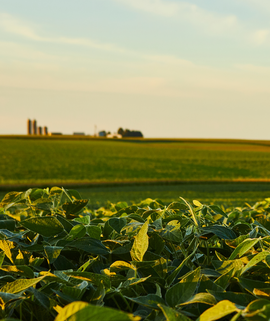Can You Afford This Farmland? Financial Factors to Consider
Buying a farm is a significant investment, whether it’s for farming, building a home or other purposes. It’s a decision that requires careful planning and consideration of various financial aspects. One of the most frequent questions we receive at Compeer Financial is, “Can I afford to buy this land?” While the answer to this question can be complex, we’ve identified key areas that can help prospective buyers make informed decisions and know how to afford farmland in this environment.
Understanding Owned Land Cost Per Acre
One of the primary factors to consider when purchasing land is the overall owned land cost per acre. This cost is calculated by adding up all your owned land loan payments and real estate taxes, then dividing this by the number of acres you own. Understanding this figure is crucial because it provides a clear picture of your annual financial commitment to buy a farm.
For instance, at Compeer Financial, the grain farm benchmark average for owned land cost is $329 per acre. If your owned land cost per acre is significantly higher than the market rent in your area, it indicates that you may need to “subsidize” your owned land payment from other income sources. This subsidy could come from other parts of your farming operation or external income streams.
Evaluating Owned Land Debt Per Acre
Another critical aspect is the overall owned land debt per acre. This is calculated by adding up all your owned land loan balances and dividing by the total number of acres you own. At Compeer, our grain benchmark average for land debt per owned acre is $3,435.
If your overall owned land debt is much higher than this benchmark, it may signal financial strain, requiring subsidies to manage the owned land cost per acre. Conversely, if your debt per acre is low but your overall owned land cost per acre is high, it might be beneficial to consider restructuring your land debt to longer terms. This approach can help reduce your annual owned land cost per acre, making the investment to buy a farm more manageable.
Additional Income Sources
Many successful landowners leverage additional income sources to subsidize their owned land payments. Over the years, we’ve seen various operations utilize income from hog barns, seed sales or non-farm activities to support their land payments. These additional revenue streams can provide the necessary financial cushion, especially if the primary income from the land is not sufficient to cover the loan payments and taxes.
|
Down Payment Considerations
The amount of cash you are willing to use as a down payment on the land purchase plays a significant role in determining your financial stability. A larger down payment reduces the loan amount and consequently the annual payments. However, it’s essential to ensure that your working capital remains at an excellent level before opting for a large down payment. Depleting your cash reserves can lead to financial difficulties in other areas of your operation.
Let’s look at a hypothetical scenario of purchasing 80 acres at $10,000 per acre, totaling $800,000. Typical lending standards for a farm purchase are 65% loan-to-value. So, let’s assume a 35% cash down payment on this purchase, which would be $280,000. That leaves $520,000 to be financed, and let’s assume a 7.5% interest rate and a 30-year term. Assuming $50 per acre for real estate taxes, your owned land cost on that 80-acre farm would be $600 per acre. The owned land cost per acre is significantly higher than market rent today and would likely require the buyer to subsidize this land payment with other income sources.
What if the buyer currently owns 80 acres that are debt-free? Their total owned land cost per acre would be $325 per acre ($44,029 divided by 160 acres = $275/acre + $50/acre in real estate taxes), which is much closer to market rent today and may not require any subsidy from other income sources.
|
If you have a potential farmland purchase in mind, the Compeer team is always willing to work through these scenarios to help you make the best financial decision for your operation.
Buying a farm involves a thorough analysis of various financial metrics to ensure a sound investment. By understanding your overall owned land cost per acre, evaluating your owned land debt per acre, leveraging additional income sources and carefully considering your down payment, you can know how to afford farmland and can make informed decisions that align with your financial goals.
Harness the Power of Benchmarking for Your F…
Benchmarking provides a clear view of where to focus efforts. Assessing these key targets can help structure your farm operation’s balance sheet for success.
Farmland Loans
Whether buying a farm or making long term improvements, we offer products to finance all your real estate needs. Learn more about farm land loans today!
Self-Paced eLearning
Access self-paced courses covering a wide range of farm financials.
